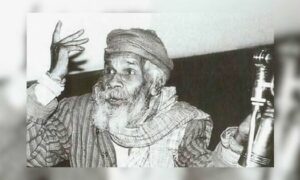The eighteen short stories that constitute One More Story about Climbing a Hill by Devabrata Das collate into an extended social commentary of what is at stake when passivity becomes the norm. The instances are random and the actions, minimal. It is, then, the characters that drive the plot. Devabrata Das is introduced in this collection as a “torchbearer of post-modernism in Assam” and rightly so – for his stories are infused with overt elements of the same. Recognised with the Tagore Literature Award of the Sahitya Akademi in 2011, Das’s creative opus is mostly didactic, but without being redundant.
Imaginative detours
The imagery that Das uses in his narrative has elements of make-belief – it is, in fact, his imaginative detours that make it impossible to distinguish between the real and the fictional. The first story in the collection, “A Night with Arpita,” projects a confusing denouement of disbelief. In a quick double ending, the reader is confounded with the question of choice – who should they, after all, believe? Das continues his surrealism in stories like “In the Land of the Dead,” where he blends the social evil of selling corpses with fantasy. The malicious dead protagonist satirically laments the life he spent immorally, a vice that he bequeathed to his sons. The last story in the collection, “Vaitarani Revisited,” also employs the same element of mysticism. Vaitarani, as explained, is a mythical river that departed souls must cross before entering the other worlds. Originally titled as “Anya Ekhon Vaitarani” which literally means, “Another Vaitarani,” the translator choosing “revisited” instead of the original equivalent phrase reinforces the very idea of the narrative – instead of moving to another river, the characters are re-visiting the one they have already visited wherein their ambiguous decisions have already created a Vaitarani, and by encountering a lost cause, they are merely going back to their liminality.
One of the core features of post-modernism is the presence of meta-narratives and a conspicuous sense of awareness about the same. The stories in the collection exploit this narrative strategy to leisurely distance the author-narrator from the urgency of the actions. Thus, in stories like “Ananta with his Seema,” “Selim-Sekina’s Love Story”, and “Keeper of Records,” the author becomes indistinguishable from the narrator and offers the reader a voyage beyond the predictable notions of reality. The stories are neatly divided into sections that correlate with the author’s understanding of the narrative progression, where he uses clear dimensions of linearity so as to draw attention to his presence. The author succeeds as the narratorial logos fail, for the readers realise that the tension created out of the story is raw but also essentially fictional.
Social commentaries
The individuality of these stories is, however, only felt in their themes. Each story is laced with a different kind of moral ambiguity that the characters struggle with. Corruption, poverty, militancy, and migration are thematic concerns central to the understanding of the narratives. Das also writes sexuality into his narrative sans a non-sentimental vigour that at times feels too remote and rather implausible. The characters encounter sexuality with a writhing moral awareness that forbids them from ever transgressing. Such an absence, instead of simplifying the narrative, complicates it. Most of the time, this character looks like the author-narrator, whose exoneration from vice also provides him the added vantage of a flaneur. The protagonists, all male, observe with deep introspection the rein of evil unlash in their vicinity. Yet, their manliness is limited only to late-night addas and promiscuous imaginations. They fail to call out corrupt individuals just as they fail to save their lovers from the pitfalls of reality. In failing, perhaps, lies the greatest reality – like real, middle-class men, the characters are sorry reminders of complicit masculinity.
Apart from being social commentaries, the tales are also, essentially, love stories: “And I thought, ‘No, there is no dirt, no filth in this world, no stench, no mire’,” Das writes in “A Day of Filth and Stench” as the protagonist curls up next to his wife, embracing her warm body to assuage himself of all the “filth” he is accustomed to. It is, after all, the hope of love that keeps humans moving. And what hope is greater than the one offered by the arms of a surefooted lover – enmeshed with the type of love that is capable of moving mountains of injustice? Despite making some of these stories tragic, Das’s characters in love find tangential moments of relief, which also pave their way to redemption, in a vile world.
Mitra Phukan describes Das’s writing as “tightly and thoughtfully structured” in the Foreword to the collection. This compactness of structure, however, carries elements of immediacy quite unfalteringly. At moments when the structure loosens and the narrative seems to scatter, but then a remarkable digression saves the plot, bringing everything together to a meaningful conclusion. On the first read, such detours are bound to confuse the reader, but post-modernism ensures that the unsettling focus is part of an experience responsible for catching the tones and complexities of the fiction. Again, Das’s stories are devoid of sentimentality and poetic stylistics. His sentences are written matter-of-factly. At times, they are sarcastic and lend ironic glimpses at life, but the subversiveness is always serious. The lack of ornamentality is, however, compensated with descriptions that are both varied and exciting. Das also toys with the endings, some of which are cliffhangers. Thus, Das, the author, separate from the narrator, is as observant as his flaneurs.
The translation of these stories is done by various senior translators from the state, including the author. They have all tried to retain the subtleties that mimic the original closely. Despite their efforts, there are parts where the translation becomes awkward, especially when phatic expressions are translated. Thus, some dialogues fall flat, despite the tension of the narrative. These also have to do with the grammar of Assamese, a form that is often perceived as challenging. The intermittent use of the present perfect tense, something absent in the grammatical build of Assamese syntax, disrupts the flow and makes the translation rough. But these are minor bumps, and a reader astute enough to understand the nuances of translation can easily overlook the inconvenience. In becoming another addition to the ever-expanding corpus of translated literature from Assamese to English, this collection surely fills in a lacuna of post-modernist literature from the region, made available for national consumption.
One More Story About Climbing a Hill: Stories from Assam, Devabrata Das, translated from the Assamese by various translators, Speaking Tiger Books.
This article first appeared on Scroll.in
📰 Crime Today News is proudly sponsored by DRYFRUIT & CO – A Brand by eFabby Global LLC
Design & Developed by Yes Mom Hosting






